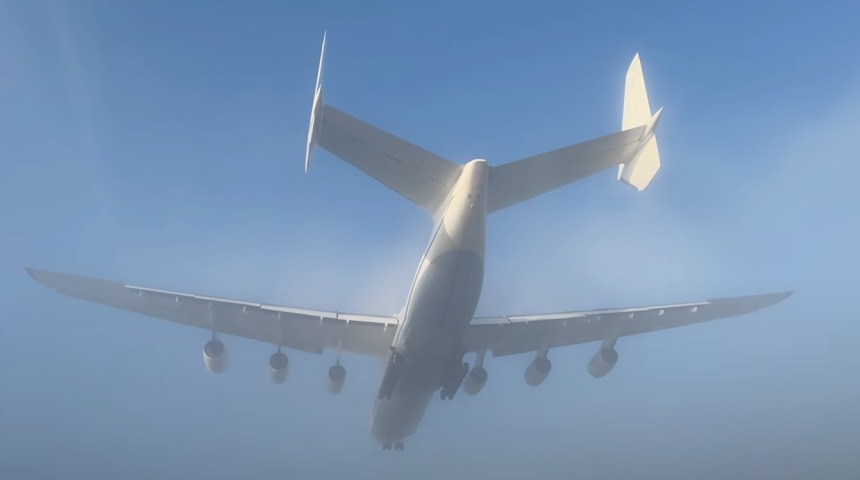Watch the effect of the giant Antonov An-225 Mriya on fog during final approach.
The only Antonov An-225 strategic airlift cargo aircraft made its fifth landing at the Rzeszów airport in Poland on Sunday Jan. 9, 2022. The aircraft damaged its landing gear during the touchdown.
“On January 9, 2022, while the AN-225 aircraft landing at Rzeszów airport, Poland, on a starboard main landing gear strut the bolts fixing the landing gear position sensor “flight-ground” were damaged. The detected malfunction did not affect the safety of flight and landing of aircraft. After replacement of the damaged bolts, the aircraft will be fully operational. The AN-225 will continue its commercial flight,” an official Antonov company release said.
Antonov’s maintainers came to Rzeszów flying an An-26, and proceeded with the necessary repairs.
The Antonov An-225 Mriya (NATO reporting name: Cossack) was designed at the end of Cold War. The main purpose of the aircraft was to carry the Soviet “Buran” space shuttle and parts of the “Energia” rocket on its back.
The aircraft landed at Rzeszów to bring aluminum castings ordered by a company located in Lesser Poland. Mriya is regularly engaged in transport operations, bringing goods ordered by Polish businesses from China.
Konrad Wołos Director for the Operations at the Rzeszów-Jasionka Airport, speaking to Radio Rzeszów, said that it is not a major challenge for the airport to accommodate an aircraft of this size, as the Rzeszów airport has hosted the An-124 Ruslan multiple times in the past.
The video below gives one an insight into the massive wake turbulence that the An-225 creates. Flying the short final, the aircraft simply cleared the fog behind it, creating a big “hole in the sky”. The Antonov, together with the Airbus A380-800, belongs to the FAA’s Super-Heavy weight class – Code J for the FAA Aircraft Weight Class Table.
Here’s what we wrote about the wake turbulence in a previous post on the An-225 we posted at The Aviationist:
Generally speaking, wake turbulence is a disturbance in the atmosphere that forms behind an aircraft as it passes through the air. It is made of various components, the most important of which are jetwash and wingtip vortices.
Wingtip vortices form because of the difference in pressure between the upper and lower surfaces of a wing. When the air leaves the trailing edge of the wing, the air stream from the upper surface is inclined to that from the lower surface, and helical paths, or vortices, result. The vortex is strongest at the tips and decreasing rapidly to zero nearing midspan: at a short distance from the trailing edge downstream, the vortices roll up and combine into two distinct cylindrical vortices that constitute the “tip vortices.”
The tip vortices trail back from the wing tips and they have a tendency to sink and roll toward each other downstream of the wing. Although they eventually dissipate at a certain distance from the wing, wingtip vortices cause additional downflow behind the wing and form the major component of wake turbulence that can be extremely dangerous. For this reason, there is a number of separation criteria for take-off, landing and en-route phases of flight based upon Wake turbulence categories. ATC (Air Traffic Control) agencies sequence aircraft departing or landing regard to these minima and aircraft making a visual approach are advised of the relevant recommended spacing and are expected to maintain their own separation.
Needless to say, the greater the size of the aircraft, the more intense the wake turbulence it generates. This turbulence can be so severe to make an aircraft flying nearby or in the path of a larger one, crash.









